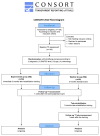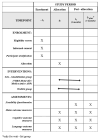TABLET TOSCANA to Develop Innovative Organizational Models for Tele-Rehabilitation in Subjects with Congenital and Acquired Developmental Disabilities: A Wait-List Control Group Trial Protocol
- PMID: 39064206
- PMCID: PMC11277580
- DOI: 10.3390/jcm13144159
TABLET TOSCANA to Develop Innovative Organizational Models for Tele-Rehabilitation in Subjects with Congenital and Acquired Developmental Disabilities: A Wait-List Control Group Trial Protocol
Abstract
Background/Objectives: In recent years, the advent of new technologies has fostered their application in neuro-psychomotor and language rehabilitation, particularly since the COVID-19 pandemic. Tele-rehabilitation has emerged as an innovative and timely solution, enabling personalized interventions monitored by clinicians. TABLET TOSCANA project aims to develop innovative tele-rehabilitation organizational models in children, adolescents and young adults with congenital and acquired developmental disabilities, using the Virtual Reality Rehabilitation System (VRRS) Home Kit and the MedicoAmico APP. Methods: The trial is designed according to the CONSORT statement guidelines. The project encompasses three phases: adapting the technologies for pediatric use, validating them through a wait-list study, and analyzing feasibility and effectiveness data to define new organizational models. A randomized wait-list-control study with 100 subjects aged 6 to 30 years will compare tele-rehabilitation versus prosecution of standard care. Discussion: Although literature highlights tele-rehabilitation benefits such as improved access, cost savings, and enhanced treatment adherence, practical implementation remains limited (i.e., the definition of standardized procedures). TABLET TOSCANA project seeks to address these gaps by focusing on multi-domain treatments for neurodevelopmental disabilities and emphasizing the integration of tele-rehabilitation into local health services. Conclusion: The project aims to improve the continuity and intensity of care through innovative models that integrate tele-rehabilitation into local health services. The results could inform healthcare policies and promote the development of innovative and collaborative models of care, paving the way for more effective and widespread tele-rehabilitation solutions and fostering collaborative networks among professionals.
Keywords: COVID-19; Information and Communication Technologies; feasibility; neurodevelopmental disorders; organizational models; pediatric neurological rehabilitation; tele-rehabilitation.
Conflict of interest statement
The authors declare no conflicts of interest.
Figures






References
-
- Edirippulige S., Reyno J., Armfield N.R., Bambling M., Lloyd O., McNevin E. Availability, Spatial Accessibility, Utilisation and the Role of Telehealth for Multi-Disciplinary Paediatric Cerebral Palsy Services in Queensland. J. Telemed. Telecare. 2016;22:391–396. doi: 10.1177/1357633X15610720. - DOI - PubMed
-
- Grumi S., Provenzi L., Gardani A., Aramini V., Dargenio E., Naboni C., Vacchini V., Borgatti R. Engaging with Families through On-line Rehabilitation for Children during the Emergency (EnFORCE) Group Rehabilitation Services Lockdown during the COVID-19 Emergency: The Mental Health Response of Caregivers of Children with Neurodevelopmental Disabilities. Disabil. Rehabil. 2021;43:27–32. doi: 10.1080/09638288.2020.1842520. - DOI - PubMed
Grants and funding
LinkOut - more resources
Full Text Sources

